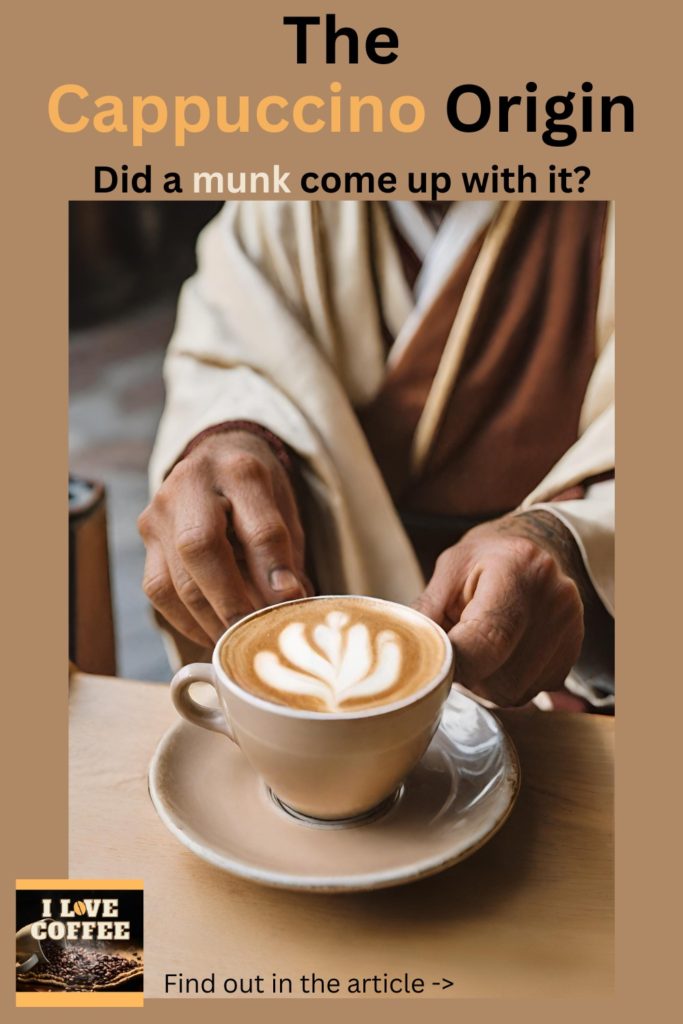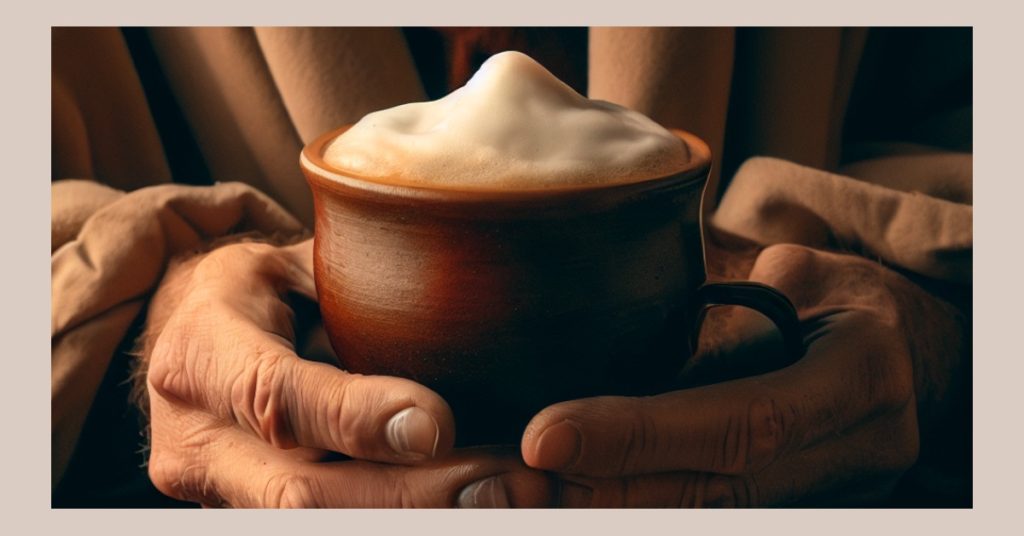Cappuccino is one of the most popular coffee drinks in the world, but do you know where it came from and how it got its name?
In this article, we will explore the fascinating history of cappuccino, from the cappuccino origin in Vienna to its evolution in Italy and beyond. We will also learn some interesting facts about cappuccino and how to make it at home.
What is Cappuccino and What Does It Mean?
Cappuccino is a coffee drink that consists of espresso, steamed milk, and foamed milk. The ratio of these ingredients is usually 1:1:1, but some variations may exist. The drink is typically served in a large cup with a thick layer of foam on top.
The word “cappuccino” comes from the Italian word “cappuccio”, which means “hood” or “cap”. This is because the drink resembles the brown hooded robe of the Capuchin monks, a branch of the Franciscan order. The Capuchin monks were named after their distinctive clothing, which was inspired by Saint Francis of Assisi, who wore a simple brown robe with a hood.
The term “cappuccino” was first used in the 18th century to describe a coffee drink that was made with whipped cream and cinnamon or chocolate. This drink was popular in Vienna, where coffee was introduced by the Turks after they failed to conquer the city in 1683. The Viennese added milk and sugar to the bitter Turkish coffee and called it “Kapuziner”. Some historians believe that this drink was influenced by the Capuchin monks who lived in Vienna at that time.
Cappuccino Origin – How Cappuccino Became an Italian Drink
The modern version of cappuccino, however, was born in Italy in the early 20th century. The invention of the espresso machine in 1901 allowed for the extraction of a strong and concentrated coffee that could be mixed with steamed milk and foamed milk. The first espresso machines were bulky and expensive, so they were only used in cafes and bars.
Cappuccino name origin:
The name “cappuccino” comes from the Italian word “cappuccio”, which means “hood” or “cap”. This is because the drink resembles the brown hooded robe of the Capuchin monks, a branch of the Franciscan order. The Capuchin monks were named after their distinctive clothing, which was inspired by Saint Francis of Assisi, who wore a simple brown robe with a hood.
The term “cappuccino” was used to describe a coffee drink that was made with espresso and hot milk in a small cup. The drink was not very popular at first, as most Italians preferred to drink espresso or caffè latte (coffee with hot milk) in the morning. Cappuccino was considered a luxury item that was only consumed by tourists or wealthy people.

The popularity of cappuccino increased after World War II, when the American soldiers who were stationed in Italy developed a taste for it. They liked the creamy and sweet drink that reminded them of home. They also introduced the custom of drinking cappuccino throughout the day, not just in the morning.
The improvement of the espresso machines in the 1950s and 1960s also contributed to the rise of cappuccino. The machines became more affordable and accessible, and they allowed for more control over the pressure and temperature of the water and steam. The baristas could create more consistent and high-quality drinks with a rich crema (the thin layer of foam on top of espresso) and a thick foam (the airy layer of milk on top of cappuccino).
The art of making cappuccino also became more refined and creative. The baristas learned how to pour the foamed milk into the espresso in different patterns and shapes, such as hearts, flowers, or leaves. This technique is called latte art, and it adds an aesthetic touch to the drink.
How Cappuccino Spread Around the World
The Cappuccino origin goes on. And so, Cappuccino became a global phenomenon in the late 20th century, thanks to the expansion of coffee chains such as Starbucks, Costa Coffee, and Caffè Nero. These chains introduced cappuccino to new markets and customers, who were attracted by the variety and customization of the drinks.
They also popularized new flavors and toppings for cappuccino, such as vanilla, caramel, hazelnut, chocolate, whipped cream, or cinnamon. You find more good coffee flavors here.
Cappuccino also influenced other coffee drinks that are based on espresso, steamed milk, and foamed milk. Some examples are:
- Latte: A coffee drink that has more steamed milk than cappuccino (usually 2:1 ratio) and less foam (usually 0.5 cm). It is served in a larger cup or glass.
- Flat white: A coffee drink that originated in Australia or New Zealand (the exact origin is disputed). It has less steamed milk than latte (usually 1:2 ratio) and more foam (usually 1 cm). It is served in a smaller cup.
- Macchiato: A coffee drink that means “stained” or “marked” in Italian. It consists of a shot of espresso with a small amount of foamed milk on top (usually 0.5 cm). It is served in a small cup or glass.
- Mocha: A coffee drink that is made with espresso, steamed milk, and chocolate syrup or powder. It may also have whipped cream and chocolate shavings on top. It is served in a large cup or glass.
Cappuccino is still one of the most beloved and consumed coffee drinks in the world, and it has a rich and fascinating history that reflects the culture and innovation of different countries and people. Whether you enjoy it in the morning or in the afternoon, with or without flavors, cappuccino is a drink that can make you feel cozy and happy.
How to Make the Perfect Cappuccino at Home: Tips and Tricks from the Experts
I always give something extra, so here you get more than just the Cappuccino history. If you want to make your own cappuccino at home, you will need some basic equipment and ingredients:
- An espresso machine or a stovetop espresso maker (also known as a moka pot)
- A milk frother or a steam wand
- A milk pitcher or a jug
- A thermometer
- A spoon
- A large cup or a mug
- Espresso beans or ground espresso
- Fresh milk (preferably whole or semi-skimmed)
- Optional: sugar, flavors, toppings
Here are the steps to follow to make the perfect cappuccino at home:
- Grind your espresso beans or use pre-ground espresso. The grind should be fine but not too fine, as it can clog the filter or make the extraction too slow. You can use a burr grinder or a blade grinder to grind your beans, but a burr grinder will give you more consistency and quality.
- Fill your espresso machine or your stovetop espresso maker with water and turn it on. The water should be hot but not boiling, as it can burn the coffee and make it bitter. The ideal temperature for espresso is between 90°C and 96°C (194°F and 205°F).
- Fill the filter basket of your espresso machine or your stovetop espresso maker with the ground espresso. The amount of coffee should be enough to fill the basket without leaving any gaps or overflowing. You can use a tamper or a spoon to press the coffee lightly and evenly but do not pack it too tightly, as it can prevent the water from flowing through.

- Attach the filter basket to your espresso machine or your stovetop espresso maker and place your cup or mug under the spout. Start the extraction process by pressing a button or turning on the heat. The extraction time should be between 20 and 30 seconds, depending on your machine and your preference. You should get about 30 ml (1 oz) of espresso per shot, with a golden-brown crema on top.
- While your espresso is brewing, froth your milk using a milk frother or a steam wand.
- To froth your milk, you will need to heat it up to about 60°C (140°F) and create tiny bubbles of air in it. You can use a thermometer to check the temperature, or you can use your hand to feel the pitcher or the jug. The milk should be hot but not scalding, and you should be able to hold it comfortably for a few seconds.
- If you are using a milk frother, pour some milk into a pitcher or a jug and insert the frother into the milk. Turn on the frother and move it up and down slowly until the milk is frothy and doubled in volume. You can also use a whisk or a blender to froth your milk, but they may not create as much foam as a frother.
- If you are using a steam wand, pour some milk into a pitcher or a jug and hold it at an angle under the steam wand. Turn on the steam and lower the pitcher until the tip of the wand is just below the surface of the milk. You should hear a hissing sound as the steam injects air into the milk. Tilt the pitcher slightly to create a whirlpool effect that will mix the air and the milk. When the milk is frothy and doubled in volume, raise the pitcher until the tip of the wand is submerged in the milk. This will heat up the milk without creating more foam.
- Tap the pitcher or the jug on a hard surface to remove any large bubbles and swirl it gently to make the foam smooth and glossy. You can also use a spoon to scoop out any excess foam if you want less foam in your cappuccino.
- Pour your frothed milk into your espresso slowly and carefully. You can use a spoon to hold back some of the foam if you want to create a clear layer of milk between the espresso and the foam. You can also use a spoon to scoop some of the foam on top of your cappuccino if you want more foam. You should aim for a 1:1:1 ratio of espresso, steamed milk, and foamed milk, but you can adjust it according to your taste.
- Enjoy your homemade cappuccino! You can add some sugar, flavors, toppings, or latte art if you like, or you can drink it plain and appreciate its natural flavor.
Looking for some inspiration for another kind of coffee. Read my coffee from Vietnam article then.
The Best Coffee Brands for Cappuccino
I thought that as we are now looking into the Cappuccino origin, it would be great to give a few advice on some of the best coffee brands for Cappuccino, so you can make it at home.
Lavazza Super Crema Whole Bean Coffee Blend: This is one of the best coffee brands for cappuccino because it is a blend of Arabica and Robusta beans that produces a smooth and creamy espresso with a rich crema. It has a balanced flavor with notes of honey, almonds, and dried fruit.
Death Wish Coffee Dark Roast Grounds: This is a strong and bold coffee brand that claims to be the world’s strongest coffee. It is made from organic and fair trade Arabica and Robusta beans that are roasted to a dark level. It has a smooth and robust flavor with hints of cherry and chocolate. See my Death Wish coffee review here.

- Kahwa Cuban Coffee Beans: This is a dark roast coffee brand that is inspired by the traditional Cuban coffee culture. It is a blend of high-quality Arabica beans from Colombia, Brazil, and Guatemala. It has a strong and full-bodied flavor with notes of vanilla, spice, and tobacco. It pairs well with milk and sugar, making it ideal for cappuccino.
- Illy Intenso Whole Bean Coffee: This is a dark roast coffee brand that is made from 100% Arabica beans sourced from nine different countries. It is roasted in Italy using the patented Illy method, which ensures consistency and quality. It has an intense and complex flavor with notes of cocoa, caramel, and toast .
- Verena Street Espresso Beans: This is a medium-dark roast coffee brand that is specially crafted for espresso machines. It is a blend of Rainforest Alliance-certified Arabica beans from South and Central America. It has a sweet and complex flavor with notes of caramel, nuts, and cocoa. It also produces a thick and rich crema that enhances the cappuccino experience.
Cappuccino Facts: Did You Know?
Here are some fun and interesting facts about cappuccino that you may not know:
- The word “cappuccino” has been used in other contexts besides coffee. For example, there is a breed of rabbits called “cappuccino rabbits” that have brown fur with white patches, resembling the drink. There is also a type of marble called “cappuccino marble” that has a beige color with brown veins, resembling the drink.
- The world record for the largest cup of cappuccino was set in 2017 by a group of Italian coffee roasters who filled a giant cup with 4,250 liters (1,122 gallons) of cappuccino. The cup measured 2.5 meters (8 feet) in height and 1.6 meters (5 feet) in diameter.
- The world record for the most cappuccinos made in one hour was set in 2012 by an Australian barista named Lachlan Ward who made 420 cappuccinos in 60 minutes. He used 63 liters (16 gallons) of milk and 10 kilograms (22 pounds) of coffee beans.
- The world record for the longest continuous cappuccino pour was set in 2014 by an Italian barista named Luigi Lupi who poured 14 liters (3.7 gallons) of cappuccino from one pitcher without stopping or spilling for 3 minutes and 19 seconds.
- The world record for the most people drinking cappuccino simultaneously was set in 2015 by a group of 2,012 people who gathered in Milan, Italy, to celebrate the International Coffee Day.
And here you find some other funny coffee facts. Have a look!
Conclusion – Cappuccino Origin
In this post on the Cappuccino origin, we have seen that the Cappuccino is more than just a coffee drink; it is a symbol of culture, history, and art. It has been influenced by different countries and people over time, and it has influenced other coffee drinks as well. It is also a versatile and customizable drink that can suit different tastes and preferences.
I hope you have enjoyed my article about the history of the cappuccino and learned something new about its origins, evolution, and facts. If you want to read more articles like this one, like for example about where do coffee originate from, well then look around.
Thank you for reading and happy brewing!

